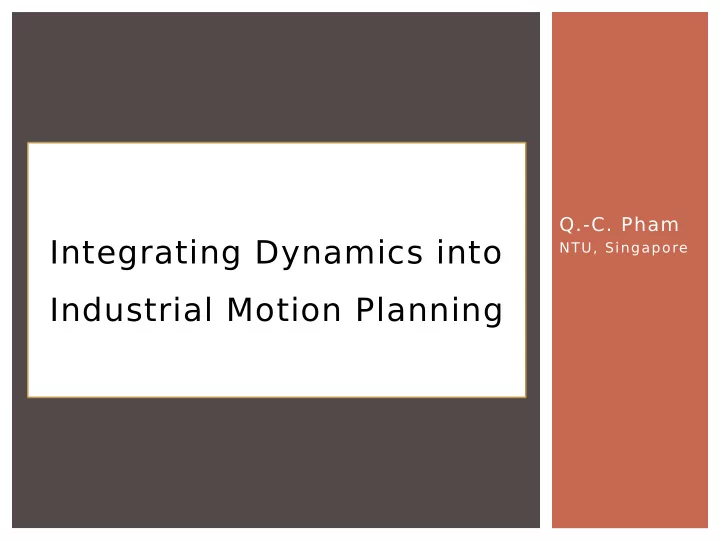

Q.-C. Pham Integrating Dynamics into NTU, Singapore Industrial Motion Planning
Path planning problem Find a collision-free path between q s t a r t and q g o a l
From academic breakthroughs... Configuration space formulation (Lozano-Perez 1983) Sampling-based planning (Kavraki et al 1996, Lavalle and Kuffner 2000) Efficient implementations ROS / MoveIt ! OpenRAVE
... to industrial successes
How about dynamics ? Torque constraints Friction constraints Fluid constraints ZMP constraints
Planning with dynamics ? Planning in the state space ? More dimensions (2n) – Obstacle avoidance difficult to guarantee – Less intuitive – Trajectory decoupling (path + parameterization) Cluttered environments – Can use regular PRM/RRT + many heuristics – Optimal time parameterization (Bobrow 1985 – and many others)
Time-Optimal Path Parameterization (TOPP) Developed by Bobrow (and many others) Applicable to many types of problems Velocity / acceleration / torque bounds Grip stability / friction constraints ZMP constraints
Time-Optimal Path Parameterization (TOPP) Our implementation of Bobrow algorithm https://github.com/quangounet/TOPP – Fast (torque constraints 7 DOF, 1s, 100 points : 6ms) – Integrated with OpenRAVE – Currently supported constraints Velocity / acceleration / torque bounds Friction constraints ZMP constraints
Sampling-based algorithm
Sampling-based algorithm
Sampling-based algorithm
Sampling-based algorithm
Sampling-based algorithm
Sampling-based algorithm
Sampling-based algorithm
Sampling-based algorithm
Sampling-based algorithm
Quasi-static planning Final path not parameterizable ? Check quasi-static feasibility at each step Loss of completeness / optimality
Admissible Velocity Propagation (AVP) Inputs Path in configuration space ( v min, v max) at the beginning of the path Output Admissible ( v min, v max) at the end of the path Pham, Caron, Nakamura RSS 2013
Admissible Velocity Propagation (AVP) Based on Bobrow algorithm Implemented in TOPP
Planning using AVP
Planning using AVP
Planning using AVP
Planning using AVP
Planning using AVP
Example : Non-prehensile transportation No need to design specific grippers Save time on grasp/release Use friction
Conclusion Approach to integrate dynamics into motion planning Can be built upon existing sampling-based planners Negligible overhead over quasi-static planning Source code available https://github.com/quangounet/TOPP Current work Liquid transportation – Humanoid robot – Integrate with other platforms – (ROS/MoveIt!...)
Recommend
More recommend